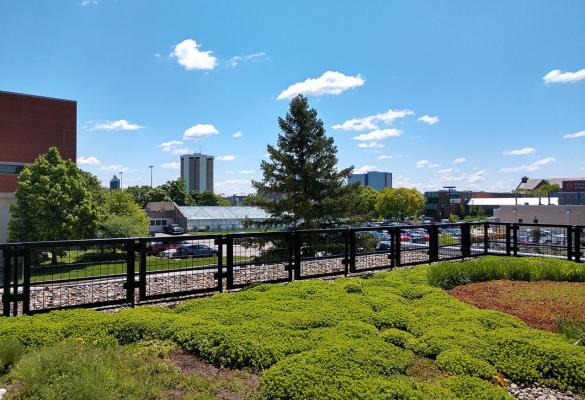Urban Greening
Urban greening is a general term used to describe efforts to renature urban areas by installing various types of green infrastructure. These revegetation strategies are often implemented with climate resilience goals in mind, but are also often cited as a way to increase local residents’ mental and physical health (García-Lamarca et al. 2022). This strategy focuses on three different forms of urban greening: urban forestry, green roofs, and pollinator gardens.
Urban forestry is an “integrated concept defined as the art, science, and technology of managing trees and forest resources in and around community ecosystems for the psychological, sociological, aesthetic, economic, and environmental benefits trees provide society” (Konijnendjik and Randrup 2004). Reforestation refers to reestablishing trees on lands that were recently covered by forest but experienced a disturbance, such as wildfire, timber harvest, or wind effects. Afforestation refers to the establishment of trees in areas that have not recently been covered in forests. Since there is no agreed-upon timeline when referring to reforestation versus afforestation and they are often used interchangeably, the term urban reforestation is used here to refer to both reforestation and afforestation, (IPCC 1998). Urban reforestation is a nature-based solution in which trees are planted in urban areas to subdue the effects of climate change and provide cobenefits to the environment and people (Ogunbode and Asifat 2021).
Green roofs, also known as vegetated roofs or living roofs, are defined by the vegetated layer growing on top of a rooftop (Figure 1; GSA 2021; EPA 2014). There are two different types of green roofs: extensive, in which lighter plants are planted and little maintenance is required; and intensive, which are similar to traditional gardens or parks and can handle most plant types, but need more structural support, higher initial investment, irrigation, and continued maintenance compared to extensive green roofs (EPA 2008). Semi-intensive green roofs represent a hybrid of both types (EPA 2021). Green roofs have layers that each perform different purposes, including plant growth, waterproofing, and structural support (EPA 2014).
Pollinator gardens are efforts to create green spaces filled with native plants that are attractive to pollinators. These gardens are typically installed to help support local pollinators, which globally have been declining due to pesticides, disease, and habitat loss. These gardens are designed to provide resources that pollinators need, including food sources (nectar and pollen), nesting sites, and larval host plants (Majewska and Altizer 2018).

Case Studies
After Record-Breaking Rains, a Major Medical Center's Hazard Mitigation Plan Improves Resilience
Bloomington, Indiana Naturalizes Creek Bank to Manage Stormwater and Establish Native Plants
Camden, New Jersey Uses Green Infrastructure to Manage Stormwater
Catalyzing Investment and Building Capacity in Las Cruces
Chicago, IL Uses Green Infrastructure to Reduce Extreme Heat
DC Utilizes Green Infrastructure to Manage Stormwater
Fortifying Chicago's Urban Forest
Goshen, Indiana Improves Ecosystem Resilience with Tree Canopy Inventory and Assessment
Green Streets Active Practice Guide, Tuscon, Arizona
GreenSeams Milwaukee, Wisconsin
Implementing Green Infrasturcture at Multiple Scales to Enhance Resilience
Improving Water Quality by Dealing with the First Inch of Rain
Innovative Green Infrastructure Project has Diverse Funding & Financing Portfolio
Integrating Education and Stormwater Management for Healthy Rivers and Residents
Investment in Infrastructure at Sea-Level Hospital Will Pay Off by Reducing Risk
Jackson Park Ecosystem Restoration
Jennings County Pollinator Habitat Program
Lick Run Watershed, Cincinnati, Ohio
Maywood Avenue Stormwater Volume Reduction Project, Toledo, Ohio
Navy Pier Redevelopment Project Serves as Model of Sustainability Using Green Infrastructure
New York City Adapts to Deal with Projected Increase of Heat Waves
Plum and Walnut St. Green Intersection
Riverfront Park, Nashville, Tennessee
Santa Cruz Riverbank and Ecosystem Restoration, Pima County, Arizona
Santa Fe River Restoration, New Mexico
School and Community Partnerships to Build Youth Stewardship and Engagement in the Mojave Desert
Smart Growth Along the Riverfront Helps Manage Stormwater in Iowa City, Iowa
The City of St. Louis Park, Minnesota Increases Green Infrastructure on Residential Properties
The Wild Mile Urban River Restoration
Using Low Impact Development Concepts to Reduce Flooding, Norfolk, Virginia
Tools
A Designer's Guide to Small-Scale Retro-fit Green Roof Planning, Design, and Implementation
Choosing Suitable Trees for Urban and Suburban Sites
Climate Adaptation Actions for Urban Forests and Human Health
Coastal & Waterfront Smart Growth
Design Guidelines and Maintenance Manual for Green Roofs in the Semi-Arid and Arid West
Ecoregional Planting Guide Cards
Green Infrastructure Effectiveness Database
Green Roofs on Historic Buildings
Mitigation Action Portfolio (MAP)
Pollinator Gardens Design Guide
Pollinator-Friendly Management Practices for Federal Lands
Promoting Nature-Based Hazard Mitigation Through FEMA Mitigation Grants
Restoration and Conservation Opportunity Maps for the conterminous U.S. (CONUS)
Selecting Plants for Extensive Green Roofs in the United States
Supporting the Health of Honey Bees and Other Pollinators
The Sustainable Urban Forest: A Step-by-Step Approach
Tools, Strategies and Lessons Learned from EPA Green Infrastructure Technical Assistance Projects
Urban Forest Assessment Resource Guide
Urban Forest Management Plan Toolkit
Urban Watershed: Urban Tree Planting Guide
Using Nature-Based Solutions Across Landscapes (Infographic)
Likely Benefits and Outcomes
This strategy is likely to achieve these project goals. Click to search for strategies with a similar benefit.
Related Green (natured-based) vs. Gray infrastructure
In development.
